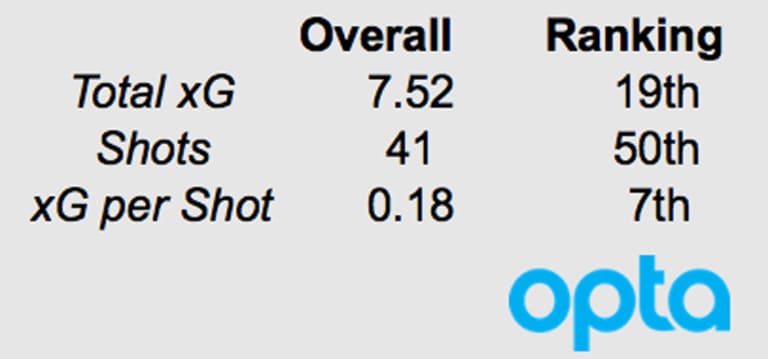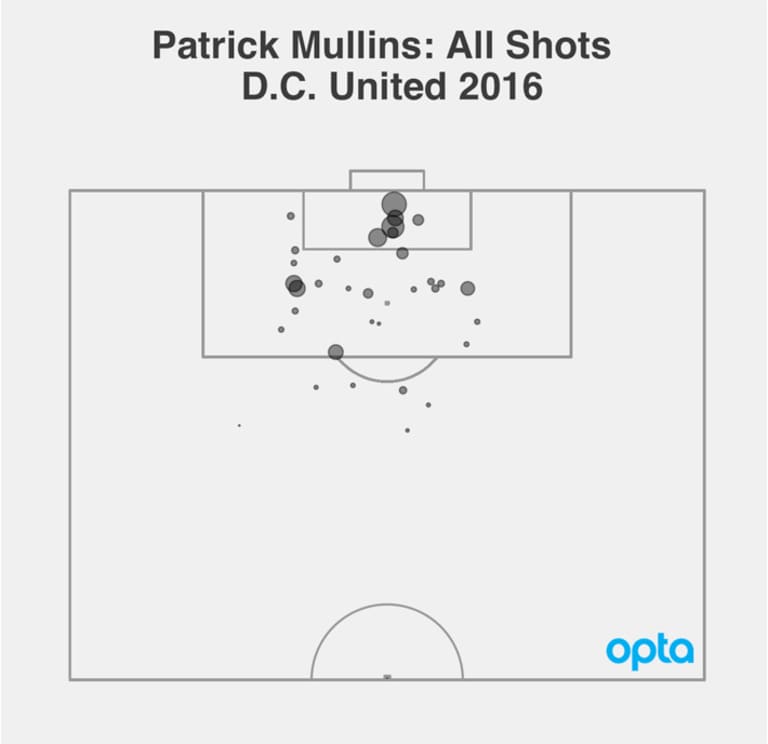The Opta Spotlight series continues at MLSsoccer.com as Opta's data scientists provide a detailed look at performance and apply their world-renowned soccer analysis to MLS.
"We're really proud of the work we do with clubs and leagues all over the world and we look forward to bringing the same top quality insight to MLS fans,” said Opta EVP Angus McNab.
Opta is the official data provider of MLS for six years running. For more of Opta’s MLS analysis, follow @OptaJack on Twitter and visit the OptaPro blog.
In what is likely to be seen as one of the best trades of this MLS season, Patrick Mullins to D.C. United has been a fantastic piece of business. Mullins has performed as well as any other striker in the league; despite having only a short amount of time to make an impact at his new team he’s already scored seven goals in just 963 minutes.
It certainly wasn’t a cheap move, however. NYCFC received general and targeted allocation money and an international roster spot until the end of 2017 in exchange for the two-time Hermann Trophy winner. D.C.’s willingness to exchange such valuable assets surely points to the inclusion of Mullins in a longer-term plan for the team.
The arrival of the former University of Maryland striker signaled a stylistic change for D.C. manager Ben Olsen, who began the season playing a 4-1-2-1-2 before switching to a 4-4-2 for 12 games. Within a game of Mullins arriving, the team changed to a 4-1-4-1 with Mullins as the lone striker, and they haven’t looked back since.
Expected Goals (xG, read more here) is a way of measuring the quality of chances a team creates. The table below shows the breakdown of the chances created between the two formations:
![Opta Spotlight: Patrick Mullins paying huge dividends for DC United - https://league-mp7static.mlsdigital.net/images/DC_Formation[1].jpg?null](https://images.mlssoccer.com/image/private/t_keep-aspect-ratio-e-mobile/f_auto/prd-league/zpps0wqx978ay7qkbwwe.jpg)
There is a small uptick in the quality of chances created when playing in a 4-1-4-1 as opposed to the 4-4-2. As minor as this change may be, it shouldn’t come as a surprise, with the installation of the 4-1-4-1 coinciding with Mullins getting starts in D.C.
Interestingly, the chance creation from Mullins himself (measured by the number of shot assists he makes) is the lowest out of all the strikers to play for D.C. this season:

This is likely due to the fact he is playing as the lone man in a 4-1-4-1 formation, whereas Fabian Espindola and Alvaro Saborio were used in a formation with two strikers up front. Logically if you are playing with two strikers up front, you’re going to have a partner to cause chaos with. As a lone striker, there is more of an onus on the midfielders to push up and help out in attack, with the striker enabling them through making space and linking the team together.
That’s not to dismiss the theory that Mullins is creating in the capital, but it’s just not captured in his shot assist numbers. His shooting numbers have been highly impressive though, despite the aforementioned limited minutes played for his new side. Taking a deeper look at Mullins’ numbers while at both D.C and NYCFC we can see just how efficient he’s been:

Despite taking relatively few shots, the quality of these chances are very high. This agrees nicely with Matt Doyle, who pointed out Mullins’ excellent movement within the box to find space, and is likely a large factor for his high quality chance generation. There’s also something to be said for his controlled shot selection, with the shot map below demonstrating just how disciplined Mullins’ shooting has been:

With the majority of his shots coming inside of the box, and even those outside (bar the anomaly on the left hand side) coming from central locations, this is the sort of shooting you want from your main striker.
Despite the volume of goods traded to get Mullins, there are some signs he’s having a very positive effect on the team. He’s young, taking shots from great positions and has brought some stability to D.C. in the form of the 4-1-4-1. If this is what he can bring to a team in just a handful of games, I look forward to finally seeing what a full season of Mullins looks like.













